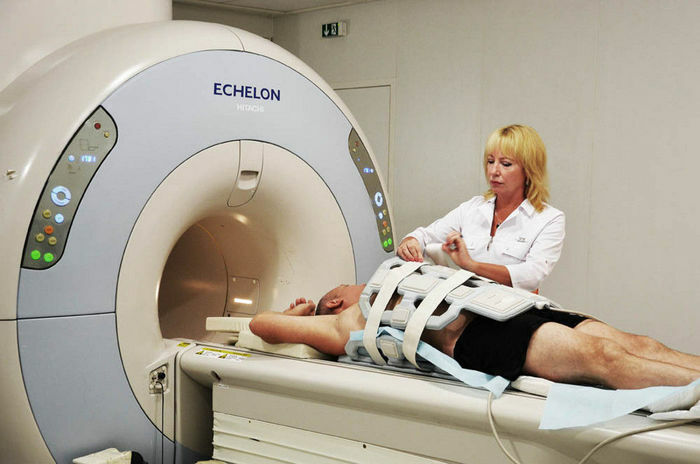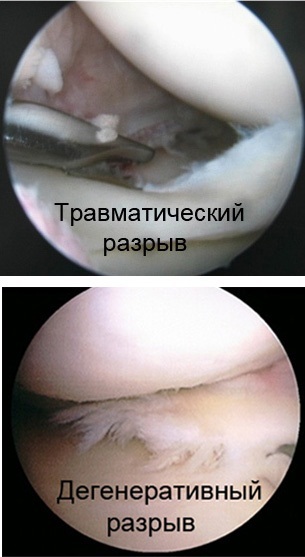Ankylosing spondylitis is a disease that affects the back causing pathological processes in the spinal column. Pathology is not treated and requires a comprehensive diagnosis to determine the provoking factor.
Correctly selected therapy will alleviate a person's condition and prevent serious complications, and also slow down the progression of inflammatory and degenerative changes.
Record content:
- 1 What is ankylosing spondylitis?
- 2 Reasons for development
- 3 Early stage symptoms
- 4 Late stage symptoms
- 5 Symptoms of damage to other organs
- 6 Diagnostics
- 7 Drug treatment
- 8 Spine straightening
- 9 Endoprosthetics of joints
- 10 Other treatments
- 11 Complications and consequences
- 12 Video about ankylosing spondylitis
What is ankylosing spondylitis?
Ankylosing spondylitis (ankylosing spondylitis, spondyloarthritis) is a disease characterized by a chronic inflammatory process in the intervertebral joints. Pathological changes provoke their fusion. Gradually, as the inflammatory processes progress, the mobility of the spinal column decreases.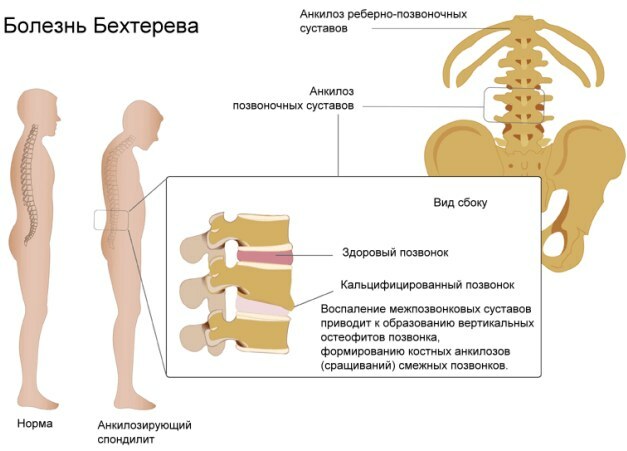
Ankylosing spondylitis develops for a long time, accompanied by periodic exacerbations. Each stage of pathological processes proceeds with characteristic symptoms, with the appearance of which a person is recommended to immediately go to the hospital.
Reasons for development
Modern experts to this day cannot say for sure what exactly provokes the inflammatory process in the spinal column.
There are numerous factors that trigger the pathological mechanism and increase the likelihood of developing ankylosing spondylitis:
- hereditary predisposition;
- infectious diseases of the digestive and urinary system;
- restless legs disease;
- the birth of a person weighing less than 3 kg;
- an autoimmune reaction of the body;
- acute infectious lesion in the period from 5 to 12 years with hospitalization of the patient.
Urogenital infections, especially of a chronic nature, provoke an inflammatory process in the spine. The same applies to weak immunity, when the body cannot fully resist other diseases.
The iliac region and sacrum are primarily affected. As the pathological processes progress, the inflammatory process spreads to other joints.
Early stage symptoms
Ankylosing spondylitis is a disease that causes inflammation in the area of the spinal column. The clinical picture with the appearance of degenerative foci depends on the development of pathological processes. Chronic illness is accompanied by constant changes.
At an early stage of pathology, patients develop the following symptoms:
| Name | Description |
| Pain syndrome | The main symptom of the disease that occurs in the region of the sacrum on one side. Pain spreads to the hip or lower back. |
| Stiffness | A pronounced sign of spondyloarthritis, which often appears in a person after a night's rest or staying in one position for a long time. During the day, the discomfort disappears on its own. A light morning warm-up will also help to cope with the stiffness of the spine. |
| Chest pain | Pathological processes affect the costal-vertebral joints. The person feels severe pain when coughing or while inhaling. In some situations, patients confuse this symptom with heart problems or intercostal neuralgia. |
| Bad mood | The disease is often accompanied by a breakdown, depression, apathy towards the world around. |
| Drooping head | Changes occur as a result of deformation of the spinal column. |
| A tight feeling in the chest area | The symptom occurs as a result of deterioration of the functioning of the ribs, so patients begin to breathe in the stomach. |
In 10-20% of cases, the disease proceeds without pronounced symptoms, without manifesting itself in any way. Pain syndrome and stiffness of the spine in patients with ankylosing spondylitis increase when a person is at rest. All of these signs of spondyloarthritis are also accompanied by limited mobility, which develops gradually.
Late stage symptoms
The advanced stage of ankylosing spondylitis is characterized by pronounced symptoms.
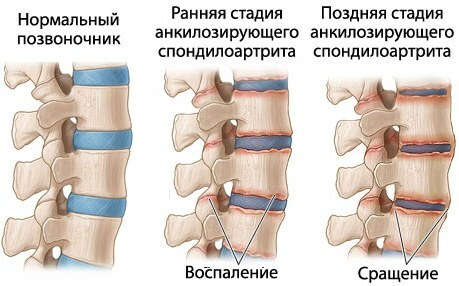
The late stages of the disease are accompanied by cardinal changes and the following signs:
| Name | Description |
| Sciatica develops | A person is worried about a strong pain syndrome in the spine, muscles grow numb, and a tingling sensation appears. Tactile sensitivity worsens, muscle tone decreases. It weakens and gradually atrophies. Painful sensations intensify when performing any physical work. |
| Blood supply to the brain is impaired | The pathological condition is accompanied by dull and throbbing headaches in the occiput. Concerned about dizziness, tinnitus and visual disturbances. Against the background of insufficient nutrition of the brain tissues, the heartbeat increases, hot flashes occur, and sweating increases. The person becomes irritable, complains of general weakness and rapid fatigability. |
| Blood pressure rises | Hypertension occurs due to poor circulation in the brain area, as a result of a heavy load on the blood vessels and the heart. |
| Suffocation appears | The clinical sign arises as a result of deterioration in the mobility of the chest, increased pressure on the bronchi, and constricted blood vessels. |
| The spine is deformed | Ossification of the joints leads to the deterioration of the mobility of the spinal column. There is a forward bending of the cervical spine, and the thoracic region is bent backward. |
The late stage of ankylosing spondylitis is dangerous in that the risk of serious complications and irreversible degenerative-dystrophic processes increases. In this case, the patient needs surgery to relieve the condition.
Symptoms of damage to other organs
Ankylosing spondylitis is also accompanied by characteristic clinical signs that arise depending on the area of localization of pathological processes.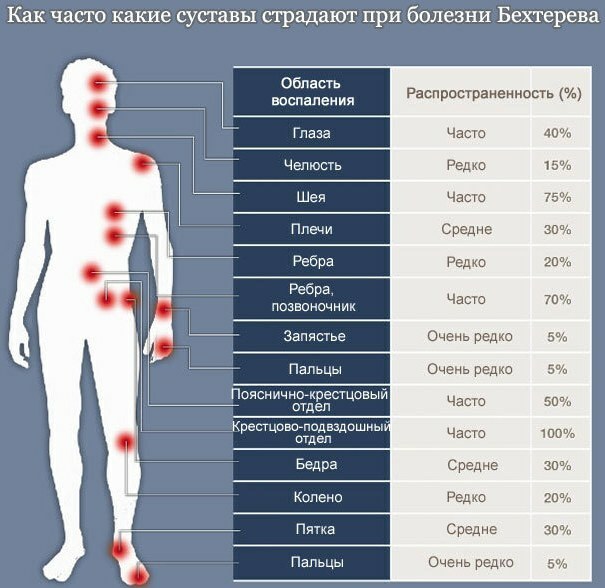
In this case, the following forms of the disease are distinguished:
| Name | Symptoms |
| Rhizomelic form | Pathological changes affect the hip joints. The clinical picture increases gradually:
|
| Peripheral shape | Pathological processes affect the joints in the knee and foot. The peripheral form of ankylosing spondylitis is accompanied by the following symptoms:
|
| Scandinavian form | The disease provokes:
|
The Scandinavian form of ankylosing spondylitis in the clinical picture resembles rheumatoid arthritis. Therefore, it is necessary to undergo a comprehensive examination in order to establish an accurate diagnosis and choose the right therapy.
Diagnostics
Ankylosing spondylitis is a serious disease that requires a comprehensive diagnosis. It is important to identify pathological changes at an early stage and start therapy in order to prevent serious complications.
To identify the inflammatory process in the spinal column, patients are assigned the following diagnostic examinations:
| Name | Description |
| Instrumental examination |
|
| Laboratory examination |
|
It is important to differentiate the disease, since many pathological processes are accompanied by similar clinical symptoms. With the first signs, you should visit a general practitioner. Taking into account the results of the examination and diagnosis, the patient may need to consult other specialized doctors (vertebrologist, rheumatologist, orthopedist, cardiologist).
Drug treatment
Treatment of ankylosing spondylitis is carried out by complex methods after diagnosis. The doctor takes into account the results obtained, the person's complaints and the individual characteristics of the organism. The main goal of properly selected therapy is to reduce the pain syndrome that accompanies the disease and to maintain the mobility of the spine.
Drug therapy involves the use of the following drugs:
| Drug group | Name | Application |
| Non-steroidal anti-inflammatory drugs | Ketoprofen, Diclofenac | Medicines are needed to reduce pain and inflammation. Adult patients should take the drug by mouth and drink plenty of water. The dosage is 50-150 mg per day. In difficult situations, the drug is administered intramuscularly. The standard course of treatment lasts 4-5 days. |
| Steroidal anti-inflammatory drugs | Prednisolone, Diprospan | The drugs help to quickly stop inflammation. Prescribed to patients if NSAIDs do not give a positive result. The daily dosage for an adult patient is 20-30 mg (4-6 tablets). |
| Broad spectrum antibiotics | Amoxicillin, Azithromycin | Tablets are prescribed to patients with an infectious lesion of the spinal column. Adults are recommended to take 0.5 g 3 times a day. The duration of therapy depends on the patient's condition and is 7-14 days. |
| Immunosuppressants | Methotrexate, Azathioprine | Medicines suppress autoimmune reactions in the human body, against which ankylosing spondylitis develops. The tablets should be swallowed whole and washed down with a little liquid. The adult dosage is 15-30 mg for 5 days, with intervals of 1-2 weeks. The course of treatment should be repeated 3-5 times. |
| Immunomodulators | Wobenzym, Protecon | The drugs stop the inflammatory process that provoke autoimmune reactions in the human body. The initial dosage for an adult patient is 5-10 pills 3 times a day. The medicine should be taken 30 minutes before meals and washed down with plenty of water. |
| Muscle relaxants | Midocalm, Sirdalud | Medicines eliminate muscle spasm, improve blood circulation and general well-being of the patient by reducing pain. The adult dosage is 50 mg 2-3 times a day. |
| Chondroprotectors | Teraflex, Rumalon | Medicines repair damaged cartilage tissue. Adult patients are advised to take 1 tablet 2 times every day. To achieve the maximum therapeutic effect, the course of treatment should be carried out for at least 6 months. |
| Vascular drugs | Pentoxifylline, Trental | The drugs improve the condition of blood vessels and blood circulation, thereby increasing the nutrition of the affected tissues. The medicine is taken orally or administered intravenously through a dropper. The adult dosage is 0.2 g 3 times a day. The medicine should be drunk after meals and washed down with a little water. The course of therapy lasts 2-3 weeks. |
| Tumor necrosis factor (TNF) blocker | Adalimumab, Stelara | The medicine is administered through an intravenous drip or by injection. The recommended dosage for an adult is 12 ml per hour, once a week for 2 months. |
| Bisphosphonates | Pamidronate, Zoledronate | The drugs help restore the process of bone metabolism. The medicine is diluted with sodium chloride or glucose before administration, then injected slowly through a dropper. The adult dosage is 90 mg every 4 weeks. |
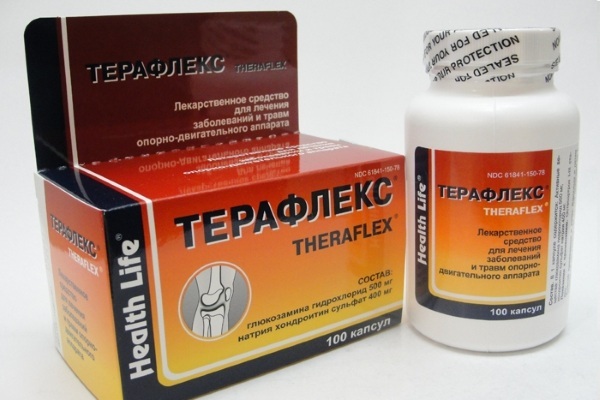
Medicines will not help to completely get rid of the disease, they can slow down the progression of pathological processes, especially at the early stage of ankylosing spondylitis. Treatment takes a long time, up to 6 months. Correctly selected and effective therapy will stop inflammation and degenerative changes. The patient's well-being will improve significantly.
Spine straightening
Ankylosing spondylitis is a disease that requires surgery in its later stages. During this period, drug therapy does not help to cope with pathological processes. The mobility of the affected joints is significantly reduced.
Progressive ankylosing spondylitis provokes forward flexion of the spinal column, thereby impairing its mobility. In this situation, a person becomes helpless. A rare occurrence, but found in medicine and requiring surgical intervention.
Indications for surgical treatment:
- the patient cannot raise his head, because the spine is severely curved;
- there are strong painful sensations that do not help stop drugs;
- disrupted work of the heart, internal organs and lungs;
- joints are affected.
During the surgical intervention, the doctor removes the vertebrae with wedge-shaped growths, due to which the spinal column is extended. The rehabilitation period after surgery lasts several months. The patient wears a special plaster corset and performs a specific set of exercises, compiled by the doctor, in order to restore the mobility of the spine.
Endoprosthetics of joints
Surgical intervention is also performed in case of complete damage, ossification of the knee and hip joints.  They are replaced with special products - prostheses. They mimic the function of the removed joint.
They are replaced with special products - prostheses. They mimic the function of the removed joint.
Other treatments
Ankylosing spondylitis is a serious medical condition that must be treated in an inpatient unit under the supervision of a physician. In addition to surgery and drug therapy, there are auxiliary methods that can also be prescribed to the patient.
| Name | Description |
| Unloading mode | During this period of treatment, patients are advised to wear a special corset or support bandage. Orthopedic products in most cases include metal inserts. |
| Massage procedures | The sessions will help prevent pressure ulcers from forming if the person is wearing a corset or bandage. Additionally, after the massage procedure, the patient's body is lubricated with camphor alcohol. |
| Heat therapy | During the treatment, blood circulation is improved, due to which spasms and painful sensations are reduced. Heat therapy involves taking a bath with the addition of fir oil or the use of paraffin applications. |
| Physiotherapy | At the stage of rehabilitation after complex treatment or surgery, patients are advised to attend physiotherapy procedures. We are talking about magnetic therapy, ultrasound treatment, hydrotherapy, phonophoresis. |
| Physiotherapy | Rehabilitation therapy, which involves long-term walking, physical activity (swimming, running, gymnastics, water aerobics). A specialized doctor will help you choose exercises to straighten your posture, stabilize the muscle corset. |
Additional therapies for ankylosing spondylitis help reduce pain and restore flexibility and mobility of the vertebrae. If there are no serious contraindications, symptomatic therapy can be carried out using folk recipes of healers and healers, but after consultation with the attending physician and in combination with others means.
Complications and consequences
In the absence of timely diagnosis and therapy, the patient will face unpleasant consequences, which will negatively affect the quality of human life: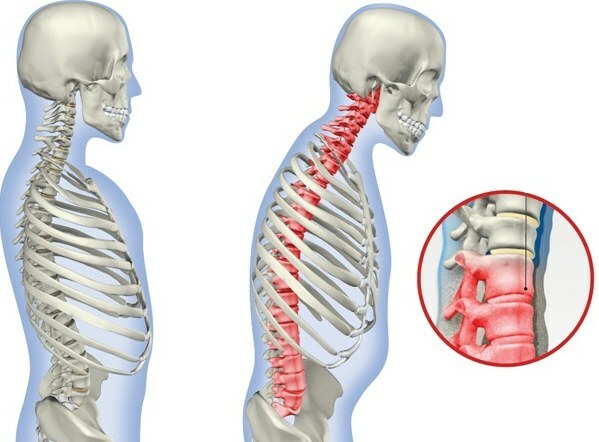
| Name | Description |
| Heart and aorta | Damage to the cardiovascular system will lead to severe shortness of breath, pain in the chest area. The general functioning of the heart is impaired. |
| Amyloidosis | Pathological processes spread to the urinary system, provoking organ failure. |
| Pneumonia, tuberculosis | Diseases occur because the mobility of the chest slows down. |
The treatment chosen by the doctor will help to prevent the complications and consequences of ankylosing spondylitis. Among all the consequences, the most dangerous one should be highlighted - this is disability. Forecasts are disappointing, especially if the patient refuses complex therapy.
Ankylosing spondylitis at an early stage, with proper and timely treatment, will allow a person to live a normal life. In some cases, patients lose their ability to work and become disabled.
Patients who are as informed as possible about their illness, adhere to the recommendations of doctors and lead a normal life. The main thing is to regularly exercise and undergo treatment in order to reduce the likelihood of complications.
Video about ankylosing spondylitis
Doctor about ankylosing spondylitis:


